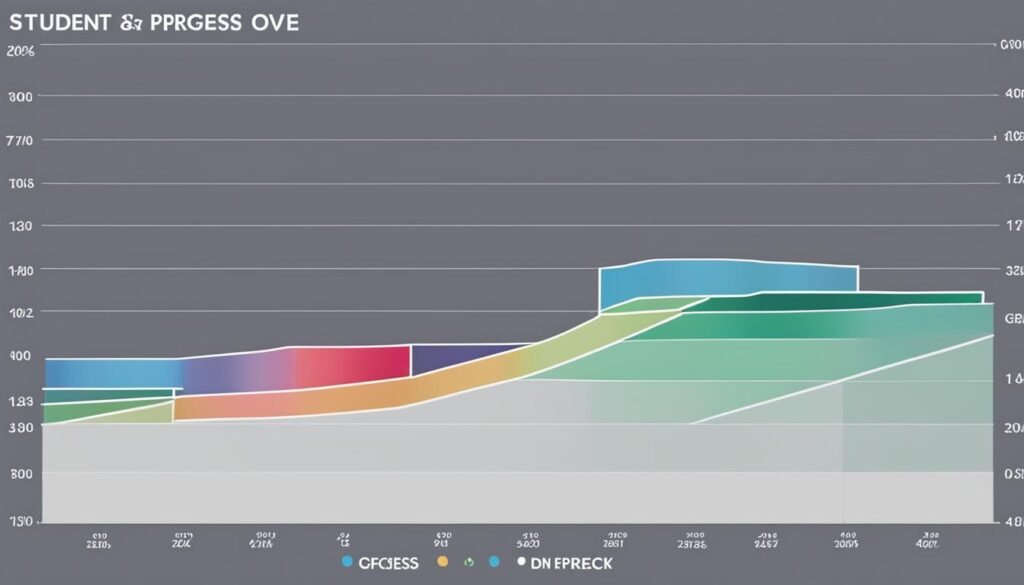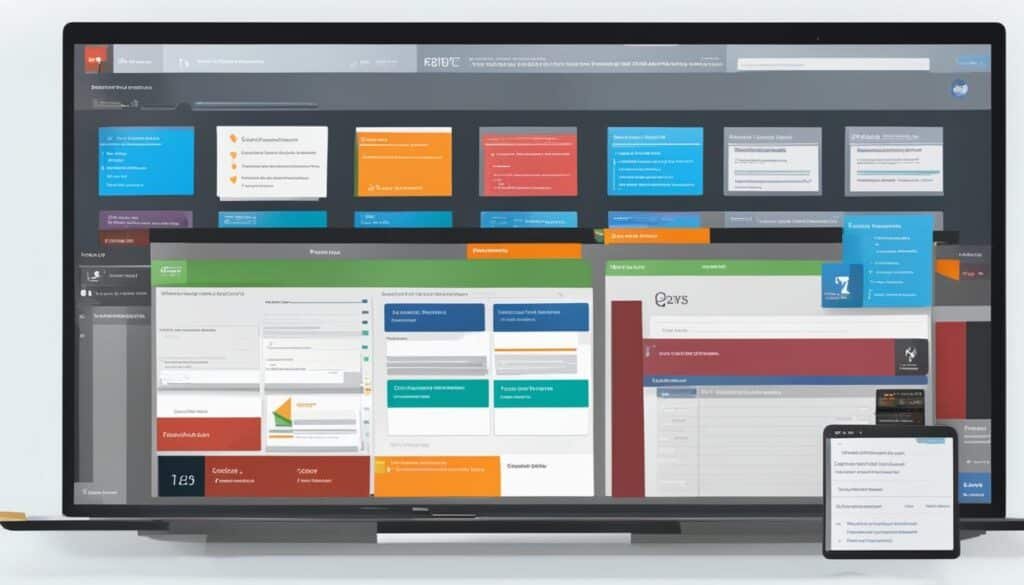In today’s competitive world, finding ways to optimize learning and educational progress is crucial. One effective solution is implementing a course management system (CMS) that can streamline curriculum planning and student tracking. A CMS is a powerful tool that can revolutionize your online training programs and maximize their effectiveness.
Also Read: Discover University Of West Georgia – Education Excellence
By utilizing the right CMS, you can enhance the efficiency of your online training efforts in major ways. From automating administrative tasks to ensuring compliance and monitoring performance, a course management system offers a wide range of benefits that can transform your training programs.
Key Takeaways:
- Implementing a course management system can optimize online training and enhance educational progress.
- A course management system streamlines curriculum planning and student tracking.
- Automating administrative tasks with a CMS saves valuable time for higher-value work.
- A CMS ensures compliance with automated recertification processes.
- Monitoring performance and making proactive adjustments is easier with a course management system.
Streamline Administrative Tasks with Automation
A course management system offers organizations the opportunity to automate various administrative tasks associated with employee training, resulting in significant time and resource savings. By leveraging the automation capabilities of a course management system, organizations can streamline multiple aspects of their training operations.
Automate Course Enrollment
One of the primary administrative tasks that can be automated with a course management system is course enrollment. Rather than manually processing enrollment requests and tracking participant data, the system can handle the entire process automatically. Learners can easily register for courses through a user-friendly interface, and the system will manage all the necessary enrollment information and updates.
Efficient Notifications and Access Control
A course management system also enables organizations to automate notifications to learners, keeping them informed about course updates, deadlines, and other important information. This eliminates the need for manual communication, saving time and ensuring consistent messaging. Additionally, access control can be automated, granting learners the appropriate permissions based on their roles and prerequisites, without the need for manual intervention.
Simplified Exam Correction and Certification
Another significant administrative task that can be automated using a course management system is exam correction. The system can efficiently grade exams, providing instant feedback to learners and saving instructors valuable time. Furthermore, upon successful completion of a course, the system can automatically award certifications, eliminating the need for manual certification management.
Also Read: Guide To The Best MCAT Prep Course: Optimize Your Study Time
| Administrative Task | Automation Benefits |
|---|---|
| Course Enrollment | Streamlines registration process and maintains accurate enrollment records |
| Notifications and Access Control | Ensures timely and consistent communication, as well as controlled access to course materials |
| Exam Correction and Certification | Saves time for instructors and provides instant feedback to learners |
By automating these administrative tasks, organizations can optimize their training operations, reduce manual workloads, and allocate resources more effectively. This allows instructors and administrators to focus on higher-value work, such as course content development and learner support, ultimately enhancing the overall efficiency and effectiveness of the training program.
Ensure Compliance with Automated Recertification
Compliance training is an essential aspect of employee development in organizations. However, managing and tracking recertification requirements can become an administrative burden. This is where a course management system comes in handy. By leveraging the capabilities of a course management system, organizations can automate the recertification process, ensuring timely completion and compliance.
One of the key features of a course management system is the ability to send automated notifications to employees, supervisors, and administrators regarding upcoming recertification deadlines. These notifications serve as reminders to complete the necessary training to maintain compliance. By automating this process, organizations can eliminate the need for manual tracking and reduce the risk of non-compliance.
In addition to automated notifications, a course management system also provides exportable reports that allow administrators to easily monitor the progress of recertification for each employee. These reports offer valuable insights into completion rates, ensuring that any gaps in compliance can be addressed promptly. With real-time access to this data, organizations can take proactive measures to ensure that all employees meet the required recertification deadlines.
Also Read: Discover the Legacy of Learning at Buena Vista University
| Benefits of Automated Recertification with a Course Management System |
|---|
| Ensures timely completion of recertification requirements |
| Reduces administrative burden by automating notifications |
| Provides exportable reports for easy monitoring and analysis |
| Promotes compliance and mitigates the risk of non-compliance |
A course management system not only simplifies the recertification process but also offers additional benefits in terms of compliance training. The system’s quiz tool allows for easy assessment of proficiency through automatic grading. This feature ensures that employees have acquired the necessary knowledge and skills to meet the compliance requirements.
By utilizing a course management system for automated recertification, organizations can streamline their compliance training processes, reduce administrative overhead, and maintain a culture of continuous learning and adherence to regulations.
Monitor Performance and Make Proactive Adjustments

Monitoring the performance of your online training program is essential for identifying areas of improvement and making proactive adjustments. With a course management system, you can gather valuable data and insights to enhance the effectiveness of your training initiatives.
Also Read: Master A New Language: Top-Rated Online Italian Course
Analyzing Learner Feedback
Learner feedback is a powerful tool for understanding the effectiveness of your training materials, delivery methods, and overall learning experience. A course management system allows you to collect feedback from learners through surveys or questionnaires. By analyzing this feedback, you can identify patterns, address any issues or concerns, and make adjustments to optimize your training program.
Segmenting Learner Groups
Segmenting your learner groups based on various criteria can provide valuable insights into the effectiveness of your training program. With a course management system, you can easily segment learners based on factors such as job roles, departments, or skill levels. By comparing the performance and progress of different segments, you can identify areas where additional support may be needed or tailor your training materials to specific learner needs.
Utilizing Analytics and Real-Time Reporting
A course management system offers robust analytics and real-time reporting capabilities, allowing you to track various metrics and monitor the progress of your learners. By analyzing data such as course completion rates, assessment scores, or engagement levels, you can identify areas of improvement and make data-driven decisions to enhance your training program’s effectiveness. Real-time reporting provides instant feedback, enabling you to address any issues promptly and ensure a seamless learning experience.
| Metric | Description |
|---|---|
| Course Completion Rate | The percentage of learners who successfully complete a course |
| Assessment Scores | The average scores achieved by learners in course assessments |
| Engagement Levels | Measures the level of learner engagement with course materials |
By leveraging the performance monitoring, learner feedback, segmenting, analytics, and real-time reporting features of a course management system, you can continuously improve your online training program and maximize its effectiveness.
Turn Your Training Program into a Revenue Stream

One of the key benefits of implementing a course management system is the opportunity to monetize your training program. By selling training courses online through your course management system, you can tap into a previously untapped market and generate additional revenue for your organization.
Also Read: Grow Your Future At The University Of Mount Olive
A course management system with eCommerce capabilities makes it easy to set up course sales and accept online payments. You can offer both digital and physical course materials, providing flexibility to your learners. Additionally, the system allows you to create promotions, coupon codes, and variable pricing options to further enhance the revenue-generating potential of your training program.
With secure online payment processing and a seamless user experience, learners can easily enroll in your courses and make payments. This streamlines the entire sales process and eliminates the need for manual payment handling.
| Benefits of Monetizing Your Training Program |
|---|
| ✓ Generate additional revenue for your organization |
| ✓ Tap into an untapped market |
| ✓ Offer flexibility with digital and physical course materials |
| ✓ Create promotions and coupon codes to attract learners |
| ✓ Utilize variable pricing options for increased profitability |
“Monetizing your training program can open up new opportunities for revenue generation and expansion. By leveraging the eCommerce capabilities of your course management system, you can easily sell your courses online and reach a wider audience. With the ability to offer flexible pricing options and create attractive promotions, you can attract more learners and boost your profitability.”
By leveraging the revenue-generating capabilities of your course management system, you can turn your training program into a valuable asset for your organization. Whether you offer internal training for employees or external courses for a broader audience, monetizing your training program can help you maximize the value of your investment in online education.
Continue reading to discover more best practices for maximizing the effectiveness of your course management system and optimizing your training programs.
Course Management Best Practices for Maximum Effectiveness

When it comes to managing your training organization and maximizing the effectiveness of your courses, implementing best practices is crucial. A Course Management System (CMS) can be a valuable tool in achieving this goal, providing the necessary features and functionalities to streamline your training operations. By following these course management best practices, you can optimize your training performance and ensure that you are making the most out of your CMS.
By employing these best practices, you can enhance the efficiency of your training organization and deliver effective courses that meet the needs of your learners. From creating course templates and integrating your CMS with your website to providing detailed course information and streamlining communication through automation, these strategies will maximize the potential of your CMS and ultimately lead to more efficient and successful training programs.
Key Takeaways:
- Implementing course management best practices is essential for maximizing the effectiveness of your training organization.
- Creating course templates and integrating your CMS with your website can improve efficiency and ensure accurate and up-to-date information.
- Record and manage training resources to avoid conflicts and ensure smooth course delivery.
- Providing comprehensive course information helps learners make informed decisions and set accurate expectations.
- Streamline communication with learners through automated messages to keep them informed and engaged throughout their training journey.
Create Course Templates for Efficiency
Creating course templates in a course management system can greatly improve efficiency in scheduling courses that are run multiple times or in the future. Course templates allow for the pre-filling of standardized information such as course name, certification, length, and description. By using these templates, instructors and administrators can save time by avoiding redundant data entry and ensure consistency across course instances.
Course templates also provide a structured framework for organizing course content, materials, and assessments. With a predefined template, instructors can focus on customizing specific elements of the course, such as learning objectives, lesson plans, and assessment criteria, while maintaining a consistent structure. This helps ensure that all courses within a program or curriculum follow a standardized format, enhancing the learning experience for students.
Moreover, course templates enable efficient scheduling by allowing instructors to easily replicate course instances with a few clicks. By selecting a template and specifying the start and end dates, instructors can quickly schedule multiple instances of a course, ensuring a smooth and timely delivery. This eliminates the need to manually recreate course details for each instance, reducing the risk of errors and saving valuable time.
Example Course Template:
| Course Name | Certification | Length | Description |
|---|---|---|---|
| Introduction to Marketing | Marketing Fundamentals | 4 weeks | An introductory course that covers the basic principles of marketing, including market research, consumer behavior, and marketing strategies. |
| Advanced Excel Techniques | Excel Mastery | 2 weeks | An advanced course that explores advanced Excel functions and techniques, including data analysis, macros, and pivot tables. |
| Project Management Essentials | Project Management Skills | 6 weeks | A comprehensive course that provides an overview of project management methodologies, tools, and techniques. |
By leveraging course templates in a course management system, organizations can significantly enhance the efficiency of their scheduling processes, improve consistency in course delivery, and ultimately optimize the overall training experience for both instructors and learners.
Integrate Your CMS with Your Website

Integrating a course management system (CMS) with your website can provide a seamless experience for both administrators and learners. By synchronizing data between the CMS and the website, you can ensure that course listings are always up to date and accurate. This integration eliminates the need for manual updates and reduces the risk of outdated information.
One of the key benefits of CMS integration is the ability to offer online payments for course enrollment. With the integration in place, learners can easily sign up for courses and make payments directly on your website, streamlining the enrollment process and improving the overall user experience.
Furthermore, CMS integration allows for better management of course listings. Any changes made in the CMS, such as adding or updating course details, will automatically reflect on your website. This ensures that learners have access to the most accurate and comprehensive course information, giving them a clear understanding of what to expect from the training program.
Benefits of CMS Integration:
- Seamless data synchronization between the CMS and website
- Online payment processing for course enrollment
- Real-time course listing updates for accurate information
- Enhanced user experience for learners
Record and Manage Training Resources

In order to ensure efficient course scheduling and smooth course delivery, it is crucial for organizations to effectively record and manage their training resources. A course management system provides the necessary tools and features to streamline resource management, including scheduling and inventory tracking.
With the help of a course management system, organizations can easily record and assign various training resources such as classrooms, equipment, and materials to specific courses. By capturing information like capacity, location, and availability, instructors and administrators can effectively plan and schedule courses, ensuring that the necessary resources are always accessible.
Furthermore, a course management system allows for efficient inventory management. Organizations can keep track of the quantity and availability of training materials, ensuring that they have an adequate supply for each course. This helps avoid conflicts and last-minute delays that may impact the delivery of training programs.
Benefits of Effective Resource Management
Implementing a robust resource management system within a course management system offers several key benefits:
- Improved scheduling efficiency: By having a clear overview of available resources, organizations can optimize the allocation of training facilities, equipment, and materials, minimizing scheduling conflicts and maximizing the use of resources.
- Enhanced course delivery: With accurate resource information at their fingertips, instructors can ensure that the necessary resources are available and ready for use, allowing for smooth and uninterrupted course delivery.
- Cost savings: Efficient resource management reduces the risk of unnecessary duplicate purchases or rental expenses, ultimately leading to cost savings for the organization.
- Enhanced learner experience: By ensuring the availability of necessary resources, organizations can provide a seamless and positive learning experience for their participants, contributing to overall satisfaction and engagement.
By leveraging the resource management capabilities of a course management system, organizations can optimize their training operations and ensure the successful delivery of learning programs.
Provide Detailed Course Information

When it comes to online training, providing comprehensive course information is crucial. By offering detailed descriptions and specifications, organizations can ensure that learners have all the necessary information to make informed decisions and set accurate expectations. Additionally, comprehensive course information serves as a centralized reference for instructors and administrators, facilitating efficient course management and planning.
Course management systems offer customizable fields that allow organizations to capture all vital information about their courses. This includes important details such as course title, instructor name, course length, prerequisites, learning objectives, and more. By filling out these fields with as much detail as possible, organizations can create a rich and informative course catalog that will attract and engage learners.
Providing comprehensive course information also helps learners understand the value and relevance of the course content. Clear descriptions of the topics covered, learning outcomes, and any additional resources or materials provided can significantly enhance learner engagement and motivation. It enables learners to align their expectations with the course content and ensures they have the necessary prerequisites or background knowledge before enrolling.
“The course information provided helped me make an informed decision about enrolling. The comprehensive details gave me a clear understanding of what to expect and allowed me to assess if the course was the right fit for my needs.” – John, a satisfied learner
Benefits of Providing Comprehensive Course Information:
- Enables learners to make informed decisions
- Sets accurate expectations for course content and requirements
- Serves as a centralized reference for instructors and administrators
- Enhances learner engagement and motivation
- Fosters transparency and trust between learners and organizations
By prioritizing detailed course information, organizations can ensure that their learners have a positive learning experience and are well-prepared to achieve their educational goals.
Table: Course Information Fields
| Field | Description |
|---|---|
| Course Title | The name or title of the course |
| Instructor Name | The name of the instructor or trainer for the course |
| Course Length | The duration or length of the course |
| Prerequisites | Any required knowledge or skills that learners should have before enrolling |
| Learning Objectives | The specific goals or outcomes that learners can expect to achieve by completing the course |
| Course Description | A detailed overview of the course content, topics covered, and teaching methodology |
| Additional Resources | Any supplementary materials, readings, or resources provided alongside the course |
By utilizing a course management system to capture and display comprehensive course information, organizations can effectively communicate the value and relevance of their courses, attract the right learners, and ensure a successful learning experience for all.
Streamline Communication with Automated Messages

In today’s fast-paced world, effective communication is crucial for the success of any training program. With a course management system, organizations can streamline communication with learners through the use of automated messages. By leveraging email templates, trigger events, and personalized content, training administrators can ensure that learners receive timely and relevant information throughout their training journey.
Automated communications allow organizations to save valuable time and resources. Instead of manually sending individual messages, the course management system can automatically trigger emails and text messages based on specific events or conditions. This eliminates tedious manual work and ensures that learners receive important updates, reminders, and notifications without delay.
The use of email templates further enhances the efficiency of automated communication. By creating pre-defined templates with standardized content, organizations can ensure consistency and accuracy in their messages. This not only saves time but also ensures that learners receive clear and cohesive information from the training program.
Personalization is another key aspect of automated communication. With a course management system, organizations can personalize the content of their messages based on learner-specific data. Whether it’s addressing learners by their names or providing relevant course recommendations based on their progress, personalized communication fosters engagement and enhances the overall learning experience.
| Benefits of Automated Communication |
|---|
| 1. Time and resource savings |
| 2. Timely and consistent communication |
| 3. Streamlined information delivery |
| 4. Enhanced learner engagement |
By streamlining communication with automated messages, organizations can effectively keep learners informed, engaged, and motivated throughout their training programs. The use of email templates, trigger events, and personalized content ensures that the right information reaches the right learners at the right time, eliminating manual effort and enhancing the overall training experience.
Conclusion
In conclusion, implementing a course management system offers a wide range of benefits that can greatly enhance the efficiency of training programs. By automating administrative tasks, organizations can save valuable time and resources, allowing them to focus on more important work. Ensuring compliance through automated recertification processes ensures that employees stay up-to-date with essential training, avoiding potential risks and legal issues. Monitoring performance and making proactive adjustments based on real-time reporting and analytics helps organizations continuously improve their training programs and achieve better results.
Moreover, turning a training program into a revenue stream can provide organizations with an additional source of income, creating new opportunities for growth. By leveraging the powerful eCommerce capabilities of a course management system, organizations can easily sell training courses online and attract a wider audience. Lastly, by employing course management best practices such as creating templates, integrating with websites, managing resources, providing detailed course information, and utilizing automation, organizations can maximize the effectiveness of their course management system and streamline their learning operations.
In summary, a course management system is an essential tool for efficient training. It offers benefits such as streamlined administrative tasks, automated recertification, performance monitoring, revenue generation, and adherence to best practices. By implementing a course management system and following these guidelines, organizations can optimize their online training efforts, improve learner engagement, and achieve greater success in their training programs.
Also Refer : Explore High-Quality Criminal Justice Courses Online Today
FAQs
Q: What is a course management system?
A: A course management software system is a software system that helps in managing and delivering training, learning materials, and activities. It can be used for elearning, instructor-led training, blended learning, and other types of learning and development activities l&d ultimate guide.
Q: How can a course management system optimize learning?
A: A course management system can optimize learning by providing a centralized platform for organizing and delivering training content, scheduling courses, tracking learning progress, and facilitating interaction between learners and instructors.
Q: What are the key features of a course management system?
A: Key features of a course management system may include content management, online course delivery, learning management system integration, reporting and analytics, and support for various types of training activities.
Q: What is the difference between a learning management system and a course management system?
A: While both systems are used for managing learning and training activities, a learning management system typically focuses on overall learning management and administration, while a course management system is more specific to managing individual courses, content delivery, and training scheduling.
Q: How can a course management system benefit training providers?
A: A course management system can benefit training providers by streamlining course scheduling, delivery, and learner management, enabling them to focus on delivering high-quality training and maximizing their training business’s efficiency.
Q: What is meant by a dashboard in a course management system?
A: In a course management system, a dashboard is a visual interface that provides at-a-glance insights into training activities, course schedules, learner progress, and other relevant information, allowing administrators and instructors to monitor and manage training operations effectively.
Q: Is it important for a course management system to offer a free trial?
A: Yes, offering a free trial allows potential users to experience the features and benefits of the course management system firsthand, helping them make an informed decision about whether it meets their training needs and preferences.
Q: How can a course management system support social learning?
A: A course management system can support social learning by providing features such as discussion forums, collaboration tools, and social media integration, which facilitate interaction and knowledge sharing among learners, fostering a collaborative learning environment.
Q: What should training companies look for in a course management system?
A: Training companies should look for a course management system that offers comprehensive training content management, scalable support for different types of training activities, robust reporting capabilities, and seamless integration with other learning and development tools.
Q: How does a cloud-based course management system differ from other types of systems?
A: A cloud-based course management system is hosted and accessed via the internet, offering the advantage of easy accessibility, scalability, and reduced infrastructure maintenance, making it suitable for organizations looking for a flexible and cost-effective learning management solution.




